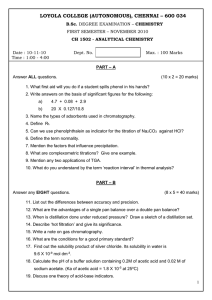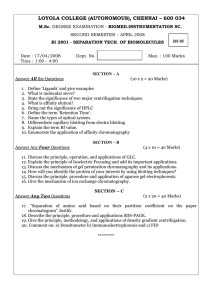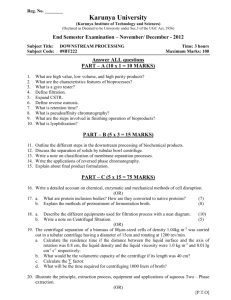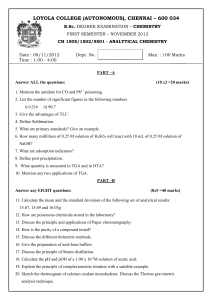LOYOLA COLLEGE (AUTONOMOUS), CHENNAI – 600 034
advertisement
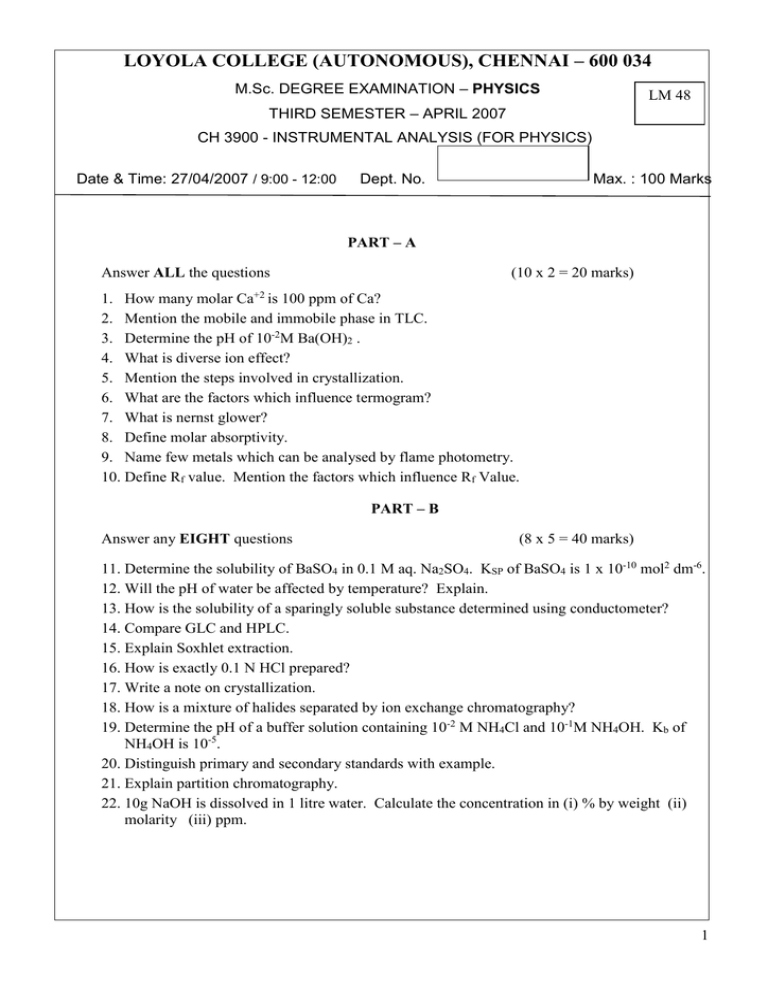
LOYOLA COLLEGE (AUTONOMOUS), CHENNAI – 600 034 M.Sc. DEGREE EXAMINATION – PHYSICS LM 48 THIRD SEMESTER – APRIL 2007 CH 3900 - INSTRUMENTAL ANALYSIS (FOR PHYSICS) Date & Time: 27/04/2007 / 9:00 - 12:00 Dept. No. Max. : 100 Marks PART – A Answer ALL the questions (10 x 2 = 20 marks) 1. How many molar Ca+2 is 100 ppm of Ca? 2. Mention the mobile and immobile phase in TLC. 3. Determine the pH of 10-2M Ba(OH)2 . 4. What is diverse ion effect? 5. Mention the steps involved in crystallization. 6. What are the factors which influence termogram? 7. What is nernst glower? 8. Define molar absorptivity. 9. Name few metals which can be analysed by flame photometry. 10. Define Rf value. Mention the factors which influence Rf Value. PART – B Answer any EIGHT questions (8 x 5 = 40 marks) 11. Determine the solubility of BaSO4 in 0.1 M aq. Na2SO4. KSP of BaSO4 is 1 x 10-10 mol2 dm-6. 12. Will the pH of water be affected by temperature? Explain. 13. How is the solubility of a sparingly soluble substance determined using conductometer? 14. Compare GLC and HPLC. 15. Explain Soxhlet extraction. 16. How is exactly 0.1 N HCl prepared? 17. Write a note on crystallization. 18. How is a mixture of halides separated by ion exchange chromatography? 19. Determine the pH of a buffer solution containing 10-2 M NH4Cl and 10-1M NH4OH. Kb of NH4OH is 10-5. 20. Distinguish primary and secondary standards with example. 21. Explain partition chromatography. 22. 10g NaOH is dissolved in 1 litre water. Calculate the concentration in (i) % by weight (ii) molarity (iii) ppm. 1 PART – C Answer any FOUR questions (4 x 10 = 40 marks) 23. Describe the instrumentation of Gas chromatography. 24. How is the pH of a solution determined by using a potentiometer? 25. How is a mixture of amino acids separated by paper chromatography? 26. Draw the thermogram of CaC2O4.H2O(s) and explain. 27. Derive Beer Lambert’s law. How is it verified? What are its limitations? 28. a) Discuss the principle of flame photometry. b) Differentiate AAS from flame photometer. ***** 2
